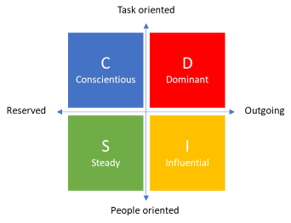If you are new to the idea of Team Praxis, please read our introduction to the concept before using the table below to improve your communications with team members, stakeholders and anyone else involved in your project, programme or portfolio.
The goals of governance are to:
- provide a system of good practice by which projects, programmes and portfolios will be managed;
- balance the differing needs of all stakeholders;
- monitor the actions of management to mitigate the risk of inappropriate actions;
- clearly define roles and responsibilities and ensure they are performed by competent people;
- ensure ethical behaviour and promote transparency.
When implementing these goals people with different character traits would perceive governance in different ways.
 Someone exhibiting concientious behaviour would typically perceive governance as: Someone exhibiting concientious behaviour would typically perceive governance as:
-
of value if robustly defined, captured and agreed to by all relevant parties; -
about the flow of reliable and precise information to aide decision making; -
requiring a central function or similar that ensures compliance to the agreed best practice. Concientious behaviour would typically propose or want to see: -
a detailed and comprehensive description that has been formally signed off and openly available; -
systematic and consistent good practice including structures and procedures to ensure a consistent and systematic approach is adopted; -
information flow and decision making happening as agreed with the team; -
monitoring of the level of complexity of the work and making changes to the agreed practice; -
a formal and, where possible, objective description of ethics and associated standards and behaviours - in particular around commitments to what will be done and how it will be done. |  Someone exhibiting dominant behaviour would typically perceive governance as: Someone exhibiting dominant behaviour would typically perceive governance as:
-
requiring defined accountabilities and performance measures for how well it operates and the value the investment in it adds; -
a means of making better and quicker decisions to mitigate the risk to delivery; -
requiring a lean central function or similar with the authority to make informed and timely decisions. Dominant behaviour would typically propose or want to see: -
a simple but robust form of governance that results in clear and speedy decision making; -
single point responsibility and accountabilities clearly laid out, communicated and formally accepted; -
sufficient freedom for leaders to make decisions and take action as they see necessary to aide delivery; -
information that is simple, summarised and objective; -
meetings that are short, structured and outcome focused and only as frequent as is necessary to make decisions that are important to delivery; -
ethics and associated standards and behaviours described in outline - in particular around the importance of meeting commitments that facilitate success. |
 Someone exhibiting steady behaviour would typically perceive governance as: Someone exhibiting steady behaviour would typically perceive governance as:
-
requiring clearly defined roles and responsibilities that are performed by competent people with adequate resources and support; -
about the individual and the capability they need to balance the needs of stakeholders around ethical and transparency issues; -
most effective when there is shared and defined responsibility for effective governance across the team. Steady behaviour would typically propose or want to see: -
governance arrangements that are focused on ensuring cooperation and balancing of the needs of different stakeholders; -
an approach that is used by all, is not overly burdensome, provides support when necessary and allows for feedback that is used when decisions are made. -
clearly identified roles and responsibilities across the team to that ensure people understand their place and the commitments they are making; -
a discussion on ethics and associated standards and behaviours - in particular around the quality of relationships and trust. |  Someone exhibiting influential behaviour would typically perceive governance as: Someone exhibiting influential behaviour would typically perceive governance as:
-
requiring only simple or informal structures and procedures that clarify how information flows and decisions are made; -
about the dynamics of how the team and stakeholders interact and share information to achieve a common aim; -
most effective when there is a shared responsibility across the team that is monitored through collective and regular communication and dialogue. Influential behaviour would typically propose or want to see: -
flexible arrangements that can be adapted to meet circumstances as they arise without limiting the team; -
the minimal level of central control and oversight to achieve the objectives; -
active involvement of teams and stakeholders to ensure they have the information needed to make effective decisions; -
an open discussion on ethics and associated standards and behaviours - in particular around the importance of building relationships and trust. |
Thanks to Donnie MacNicol of Team Animation for providing this page.


 Someone exhibiting concientious behaviour would typically perceive governance as:
Someone exhibiting concientious behaviour would typically perceive governance as: Someone exhibiting dominant behaviour would typically perceive governance as:
Someone exhibiting dominant behaviour would typically perceive governance as: Someone exhibiting steady behaviour would typically perceive governance as:
Someone exhibiting steady behaviour would typically perceive governance as: Someone exhibiting influential behaviour would typically perceive governance as:
Someone exhibiting influential behaviour would typically perceive governance as:



